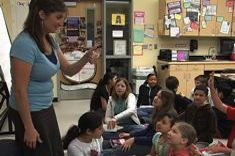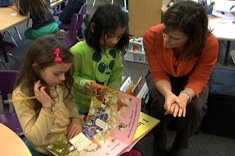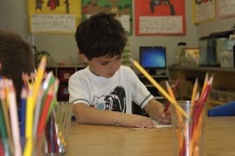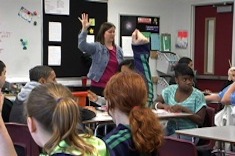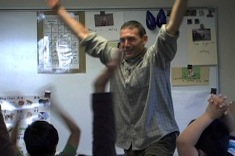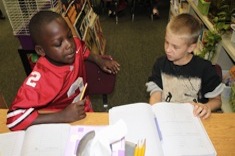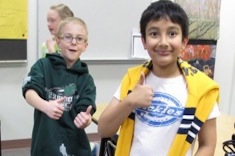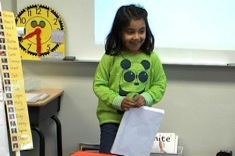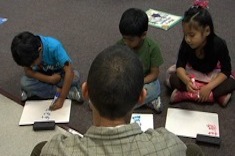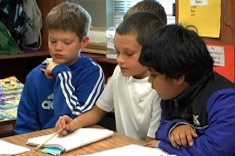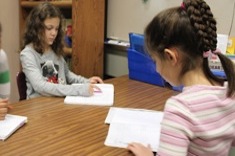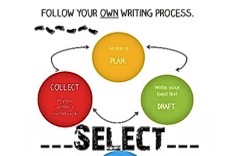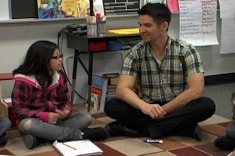Teaching Writing
Everyone who writes for Choice Literacy loves teaching writing, because we all write ourselves. We know it is "hard fun," as Donald Murray famously said—exasperating and exhilarating at the same time. The writing workshops you will read about here and see in our videos are busy, noisy, vibrant places. And most days, we wouldn't want to be anywhere else than in the midst of 'em! Here is where you'll find our latest discoveries, insights, and occasional boneheaded mistakes in teaching writing.
Latest Content
The Truth About Building a Writing Community in Middle School
Building a sense of community is complicated in middle school classrooms. Katie Baydo-Reed considers her eighth graders, and is surprised at what endures most with these young teens.
Shared Reading to Explore Writer’s Craft in First Grade
Katie DiCesare’s first graders reread a favorite text in pairs to work on noticing the details of writer’s craft.
Make a Note
Why is Leslie Woodhouse so forgetful? It’s all part of a not-so-devious plot to teach her preschool students the power of creating and leaving notes throughout the classroom.
Introducing Annotation in Eighth Grade
Katie Baydo-Reed introduces the concept of annotating text to her eighth-grade students.
Sketching Trees in Winter
The seasons are like bulbs, fat and full underground. In their time, they edge up and unfold with meaning. Shirl McPhillips finds inspiration from the darkest days of winter in her latest poetry offering.
Weaving Word Study into Writing Workshop in 5th Grade
Maria Caplin describes how she integrates word study with intermediate students in writing workshops.
Highlighting Language in a Writing Conference
Karen Terlecky confers with fifth grader Nora about her evocative language during writing workshop.
Linking Movement, Minds, and Literacy in Kindergarten
Max Brand explains how movement activities in classrooms with young learners can be so much more than a brain break or “getting the wiggles out”: movement can forge potent connections between mind, body, and story. The essay includes two video examples.
Student-Selected Vocabulary in Middle School
Katie Doherty shares many ways to make vocabulary learning fun in middle school, beginning with students working together to select words to study each week.
From “Show Me the Lessons” to Sustainable Planning (Part 4 of the Opinion/Argument Writing Series)
This is the final installment in Heather Rader's series on argument and opinion writing in the intermediate grades.
Movement with First Graders
Katie DiCesare leads her first-grade students through movements and a song, and explains in the debrief why movement activities are valuable for young learners.
Peer Conferring: The Release Phase
Amanda Adrian concludes her series on peer conferring, analyzing the value of students working on their own after instruction and practice.
Looking for the Open Door
Midyear is a wonderful time for taking conferences to the next level, now that you know your students well and they trust you. Beth Lawson gently challenges a young writer in her fourth-grade classroom to reach his full potential.
Lists, Facts, and Reports: Conferring with Anna
Franki Sibberson confers with fourth grader Anna to help her connect report writing with her love of animal lists.
Touchy Topics for Opinion/Argumentative Writing
When students take a stand in writing, they will almost inevitably bring up touchy topics. Heather Rader considers the challenge in part 3 of her opinion/argumentative writing series.
Helping Richard Revise
Karen Terlecky coaxes Richard to cut extraneous material from his writing by highlighting the strengths of his writing first in this video from her fifth grade classroom.
Building Peer Conferring Skills in the Primary Grades
Ann Marie Corgill questions whether her second graders are ready for peer response. She finds that with some guidance and construction of anchor charts together, the answer is a resounding yes.
Lifting the Quality of Peer Response
Tony Keefer discovers that his fourth-grade students need focused instruction and support to strengthen their peer conferring skills. Tony shares tips and two video examples from his classroom.
Whole Class Writing Share: Teaching Response Skills in 1st Grade
Katie DiCesare’s first graders respond to their classmates’ writing, using questions they developed together over time.
Thank You For Arguing
In the second installment of our teaching argument/opinion writing series, Heather Rader uses a continuum dialogue and modeled writing with intermediate students.
Using Wipe-Off Boards with Young English Language Learners
Max Brand describes why wipe-off boards are such a valuable tool for work with young English language learners in small groups. The article includes a video demonstration.
It’s Not About the Tool — It’s About the Learning
Maria Caplin explains step by step how she integrated the use of iPods into her writing workshop, helping students use them to record notes and create persuasive texts.
Brainstorming Student Blogs
Franki Sibberson works with a group of students who want to create a collaborative blog of interviews. The discussion reveals some of the challenges of blog writing, including consistent posting and developing topics that might endure over time.
Two Teachers and One Kindergartner
Principal Jennifer Schwanke looks at the challenging issue of retention and the power of teamwork.
Word Count
Ruth Ayres finds that keeping a word count is a potent way to increase writing quality over time.
The Writing Process . . . and Processes
Ruth Ayres considers elements of the writing process that are common to all, and which ones vary according to the needs, interests, and quirks of writers.
I Love a Good Argument
As Heather Rader works with teachers and teams on opinion/argumentative writing, she’s considering the anatomy of an argument and engaging ways to teach it.
Just Write More
Aimee Buckner has tips for ways to focus lessons that will help students produce more writing.
Second Grade Whole-Class Share: Adding Details and Descriptive Language Part 4
In this final video from a four-part series, Sean Moore asks students to share their writing with peers and the whole class.
Second Grader Student Mentor Text: Adding Details and Descriptive Language Part 3
In this third video from a four-part series, Sean Moore has a student share his writing as a mentor text for the class.
Browse Content By
Type
Category
- Assessment Tools
- Big Fresh Archives
- Booklists
- Choice Numeracy
- Classroom Design
- Common Core
- Community Building
- Conferring
- Content Literacy
- Digital Literacy
- English Language Learners
- Equity
- Family Relations
- Free Samples
- Guiding Groups
- Leadership
- Literacy Coaches
- Mentor Texts
- Minilessons
- New Teacher Mentors
- Podcasts
- Poetry
- Quote Collections
- Reading Strategies
- Self Care
- Struggling and Striving Learners
- Talking and Listening
- Teacher Study Groups
- Teaching Reading
- Teaching Writing
- Word Study and Vocabulary
Author
- Melissa Quimby
- Nawal Qarooni
- Gwen Blumberg
- Julie Cox
- The Lead Learners
- Hannah Tills
- Josie Stewart
- Ruth Metcalfe
- Mallory Messenger
- Becca Burk
- Jodie Bailey
- Vivian Chen
- Mary Brower
- Tiffany Abbott Fuller
- Stephanie Affinito
- Ruth Ayres
- Leigh Anne Eck
- Heather Fisher
- Shari Frost
- Julie Johnson
- Suzy Kaback
- Gigi McAllister
- Shirl McPhillips
- Melanie Meehan
- Cathy Mere
- Debbie Miller
- Tara Barnett and Kate Mills
- Tammy Mulligan
- Dana Murphy
- Bitsy Parks
- David Pittman
- Brenda Power
- Heather Rader
- Matt Renwick
- Mandy Robek
- Christy Rush-Levine
- Gretchen Schroeder
- Jen Schwanke
- Brian Sepe
- Katherine Sokolowski
- Stella Villalba
- Jennifer Vincent
Grade Level
Choice Literacy Membership
Articles
Get full access to all Choice Literacy article content
Videos
Get full access to all Choice Literacy video content
Courses
Access Choice Literacy course curriculum and training

